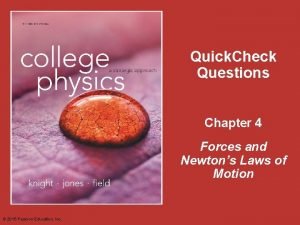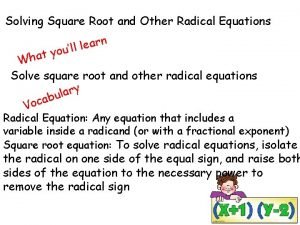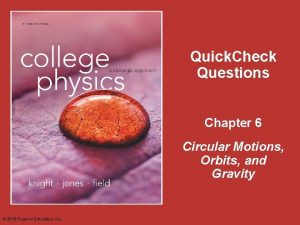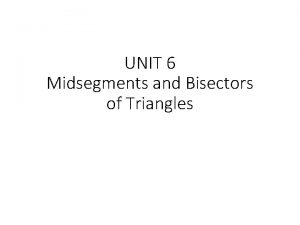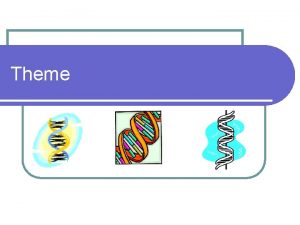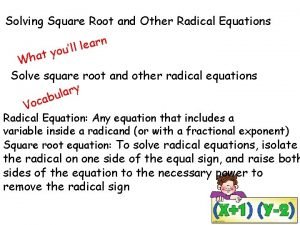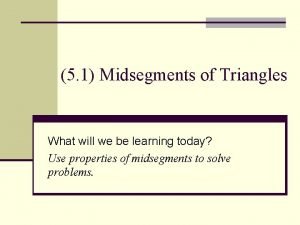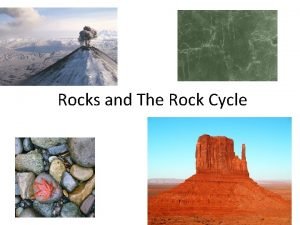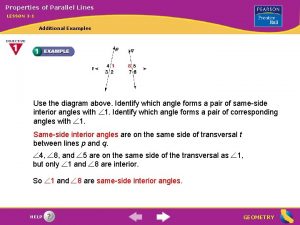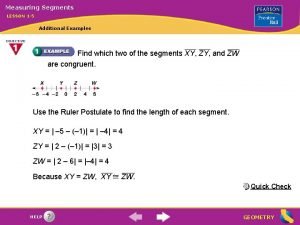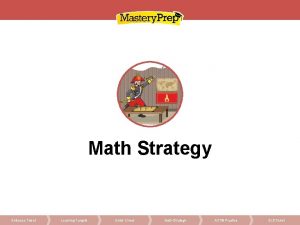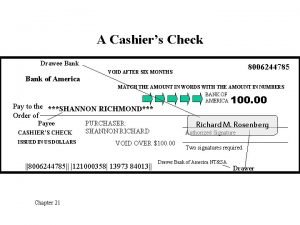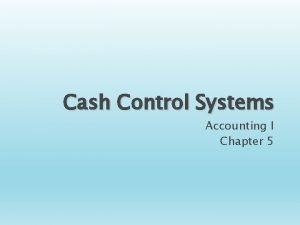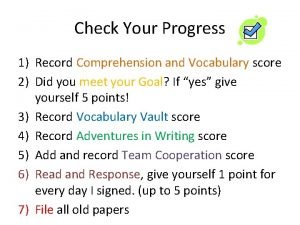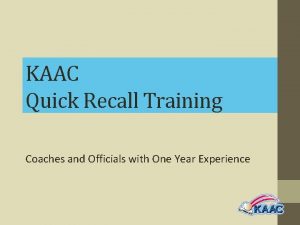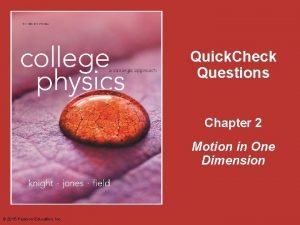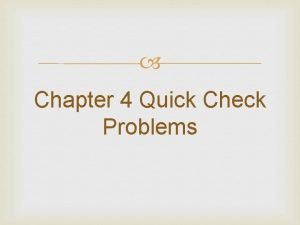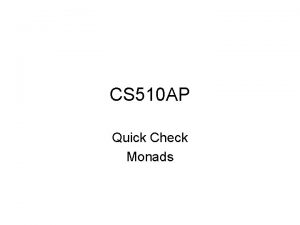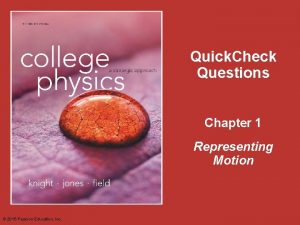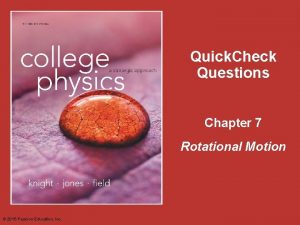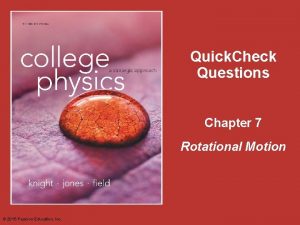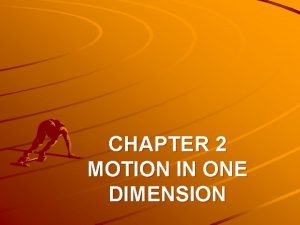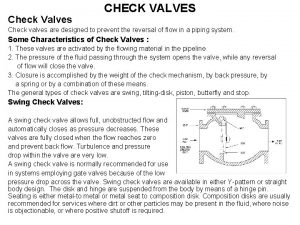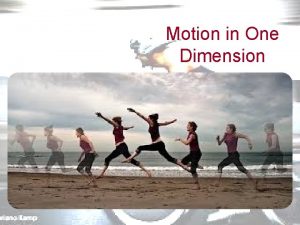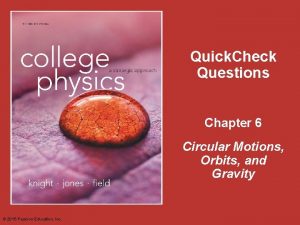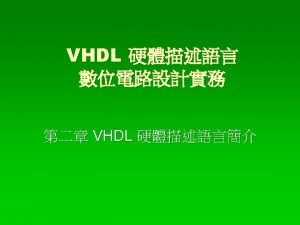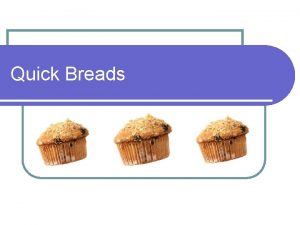Quick Check Questions Chapter 2 Motion in One

























































- Slides: 57

Quick. Check Questions Chapter 2 Motion in One Dimension © 2015 Pearson Education, Inc.

Quick. Check 2. 1 Here is a motion diagram of a car moving along a straight road: Which position-versus-time graph matches this motion diagram? © 2015 Pearson Education, Inc. Slide 2 -2

Quick. Check 2. 1 Here is a motion diagram of a car moving along a straight road: Which position-versus-time graph matches this motion diagram? E. © 2015 Pearson Education, Inc. Slide 2 -3

Quick. Check 2. 2 Here is a motion diagram of a car moving along a straight road: Which velocity-versus-time graph matches this motion diagram? E. None of the above. © 2015 Pearson Education, Inc. Slide 2 -4

Quick. Check 2. 2 Here is a motion diagram of a car moving along a straight road: Which velocity-versus-time graph matches this motion diagram? C. E. None of the above. © 2015 Pearson Education, Inc. Slide 2 -5

Quick. Check 2. 3 Here is a motion diagram of a car moving along a straight road: Which velocity-versus-time graph matches this motion diagram? © 2015 Pearson Education, Inc. Slide 2 -6

Quick. Check 2. 3 Here is a motion diagram of a car moving along a straight road: Which velocity-versus-time graph matches this motion diagram? D. © 2015 Pearson Education, Inc. Slide 2 -7

Quick. Check 2. 4 A graph of position versus time for a basketball player moving down the court appears as follows: Which of the following velocity graphs matches the position graph? A. © 2015 Pearson Education, Inc. B. C. D. Slide 2 -8

Quick. Check 2. 4 A graph of position versus time for a basketball player moving down the court appears as follows: Which of the following velocity graphs matches the position graph? A. © 2015 Pearson Education, Inc. B. C. D. Slide 2 -9

Quick. Check 2. 5 The slope at a point on a position-versus-time graph of an object is A. B. C. D. E. The object’s speed at that point. The object’s velocity at that point. The object’s acceleration at that point. The distance traveled by the object to that point. I am not sure. © 2015 Pearson Education, Inc. Slide 2 -10

Quick. Check 2. 5 The slope at a point on a position-versus-time graph of an object is A. B. C. D. E. The object’s speed at that point. The object’s velocity at that point. The object’s acceleration at that point. The distance traveled by the object to that point. I am not sure. © 2015 Pearson Education, Inc. Slide 2 -11

Quick. Check 2. 6 A graph of velocity versus time for a hockey puck shot into a goal appears as follows: Which of the following position graphs matches the velocity graph? A. © 2015 Pearson Education, Inc. B. C. D. Slide 2 -12

Quick. Check 2. 6 A graph of velocity versus time for a hockey puck shot into a goal appears as follows: Which of the following position graphs matches the velocity graph? A. © 2015 Pearson Education, Inc. B. C. D. (d) Slide 2 -13

Quick. Check 2. 7 Which velocity-versus-time graph goes with this position graph? © 2015 Pearson Education, Inc. Slide 2 -14

Quick. Check 2. 7 Which velocity-versus-time graph goes with this position graph? C. © 2015 Pearson Education, Inc. Slide 2 -15

Quick. Check 2. 8 Here is a position graph of an object: At t = 1. 5 s, the object’s velocity is A. B. C. D. E. 40 m/s 20 m/s 10 m/s – 10 m/s None of the above © 2015 Pearson Education, Inc. Slide 2 -16

Quick. Check 2. 8 Here is a position graph of an object: At t = 1. 5 s, the object’s velocity is A. B. C. D. E. 40 m/s 20 m/s 10 m/s – 10 m/s None of the above © 2015 Pearson Education, Inc. Slide 2 -17

Quick. Check 2. 9 When do objects 1 and 2 have the same velocity? A. At some instant before time t 0 B. At time t 0 C. At some instant after time t 0 D. Both A and B E. Never © 2015 Pearson Education, Inc. Slide 2 -18

Quick. Check 2. 9 When do objects 1 and 2 have the same velocity? A. At some instant before time t 0 B. At time t 0 C. At some instant after time t 0 D. Both A and B E. Never Same slope at this time © 2015 Pearson Education, Inc. Slide 2 -19

Quick. Check 2. 10 Masses P and Q move with the position graphs shown. Do P and Q ever have the same velocity? If so, at what time or times? A. B. C. D. P and Q have the same velocity at 2 s. P and Q have the same velocity at 1 s and 3 s. P and Q have the same velocity at 1 s, 2 s, and 3 s. P and Q never have the same velocity. © 2015 Pearson Education, Inc. Slide 2 -20

Quick. Check 2. 10 Masses P and Q move with the position graphs shown. Do P and Q ever have the same velocity? If so, at what time or times? A. B. C. D. P and Q have the same velocity at 2 s. P and Q have the same velocity at 1 s and 3 s. P and Q have the same velocity at 1 s, 2 s, and 3 s. P and Q never have the same velocity. © 2015 Pearson Education, Inc. Slide 2 -21

Quick. Check 2. 11 Here is the velocity graph of an object that is at the origin (x 0 m) at t 0 s. At t 4. 0 s, the object’s position is A. B. C. D. E. 20 m 16 m 12 m 8 m 4 m © 2015 Pearson Education, Inc. Slide 2 -22

Quick. Check 2. 11 Here is the velocity graph of an object that is at the origin (x 0 m) at t 0 s. At t 4. 0 s, the object’s position is A. B. C. D. E. 20 m 16 m 12 m Displacement area under the curve 8 m 4 m © 2015 Pearson Education, Inc. Slide 2 -23

Quick. Check 2. 12 A particle has velocity as it moves from point 1 to point 2. The acceleration is shown. What is its velocity vector as it moves away from point 2? © 2015 Pearson Education, Inc. Slide 2 -24

Quick. Check 2. 12 A particle has velocity as it moves from point 1 to point 2. The acceleration is shown. What is its velocity vector as it moves away from point 2? B. © 2015 Pearson Education, Inc. Slide 2 -25

Quick. Check 2. 13 A car moves along a straight stretch of road. The following graph shows the car’s position as a function of time: At what point (or points) do the following conditions apply? • • The displacement is zero. The speed is increasing. The speed is decreasing. © 2015 Pearson Education, Inc. Slide 2 -26

Quick. Check 2. 13 A car moves along a straight stretch of road. The following graph shows the car’s position as a function of time: At what point (or points) do the following conditions apply? • • The displacement is zero. The speed is increasing. The speed is decreasing. © 2015 Pearson Education, Inc. D B, E C A Slide 2 -27

Quick. Check 2. 14 The motion diagram shows a particle that is slowing down. The sign of the position x and the sign of the velocity vx are: A. B. C. D. Position is positive, velocity is positive. Position is positive, velocity is negative. Position is negative, velocity is positive. Position is negative, velocity is negative. © 2015 Pearson Education, Inc. Slide 2 -28

Quick. Check 2. 14 The motion diagram shows a particle that is slowing down. The sign of the position x and the sign of the velocity vx are: A. B. C. D. Position is positive, velocity is positive. Position is positive, velocity is negative. Position is negative, velocity is positive. Position is negative, velocity is negative. © 2015 Pearson Education, Inc. Slide 2 -29

Quick. Check 2. 15 The motion diagram shows a particle that is slowing down. The sign of the acceleration ax is: A. Acceleration is positive. B. Acceleration is negative. © 2015 Pearson Education, Inc. Slide 2 -30

Quick. Check 2. 15 The motion diagram shows a particle that is slowing down. The sign of the acceleration ax is: A. Acceleration is positive. B. Acceleration is negative. © 2015 Pearson Education, Inc. Slide 2 -31

Quick. Check 2. 16 A cyclist riding at 20 mph sees a stop sign and actually comes to a complete stop in 4 s. He then, in 6 s, returns to a speed of 15 mph. Which is his motion diagram? © 2015 Pearson Education, Inc. Slide 2 -32

Quick. Check 2. 16 A cyclist riding at 20 mph sees a stop sign and actually comes to a complete stop in 4 s. He then, in 6 s, returns to a speed of 15 mph. Which is his motion diagram? B. © 2015 Pearson Education, Inc. Slide 2 -33

Quick. Check 2. 17 These four motion diagrams show the motion of a particle along the x-axis. 1. Which motion diagrams correspond to a positive acceleration? 2. Which motion diagrams correspond to a negative acceleration? © 2015 Pearson Education, Inc. Slide 2 -34

Quick. Check 2. 17 These four motion diagrams show the motion of a particle along the x-axis. 1. Which motion diagrams correspond to a positive acceleration? 2. Which motion diagrams correspond to a negative acceleration? Positive Negative © 2015 Pearson Education, Inc. Slide 2 -35

Quick. Check 2. 18 Mike jumps out of a tree and lands on a trampoline. The trampoline sags 2 feet before launching Mike back into the air. At the very bottom, where the sag is the greatest, Mike’s acceleration is A. Upward. B. Downward. C. Zero. © 2015 Pearson Education, Inc. Slide 2 -36

Quick. Check 2. 18 Mike jumps out of a tree and lands on a trampoline. The trampoline sags 2 feet before launching Mike back into the air. At the very bottom, where the sag is the greatest, Mike’s acceleration is A. Upward. B. Downward. C. Zero. © 2015 Pearson Education, Inc. Slide 2 -37

Quick. Check 2. 19 A cart slows down while moving away from the origin. What do the position and velocity graphs look like? © 2015 Pearson Education, Inc. Slide 2 -38

Quick. Check 2. 19 A cart slows down while moving away from the origin. What do the position and velocity graphs look like? D. © 2015 Pearson Education, Inc. Slide 2 -39

Quick. Check 2. 20 A cart speeds up toward the origin. What do the position and velocity graphs look like? © 2015 Pearson Education, Inc. Slide 2 -40

Quick. Check 2. 20 A cart speeds up toward the origin. What do the position and velocity graphs look like? C. © 2015 Pearson Education, Inc. Slide 2 -41

Quick. Check 2. 21 A cart speeds up while moving away from the origin. What do the velocity and acceleration graphs look like? © 2015 Pearson Education, Inc. Slide 2 -42

Quick. Check 2. 21 A cart speeds up while moving away from the origin. What do the velocity and acceleration graphs look like? B. © 2015 Pearson Education, Inc. Slide 2 -43

Quick. Check 2. 22 Here is a motion diagram of a car speeding up on a straight road: The sign of the acceleration ax is A. Positive. B. Negative. C. Zero. © 2015 Pearson Education, Inc. Slide 2 -44

Quick. Check 2. 22 Here is a motion diagram of a car speeding up on a straight road: The sign of the acceleration ax is A. Positive. B. Negative. C. Zero. © 2015 Pearson Education, Inc. Speeding up means vx and ax have the same sign. Slide 2 -45

Quick. Check 2. 23 A cart slows down while moving away from the origin. What do the velocity and acceleration graphs look like? © 2015 Pearson Education, Inc. Slide 2 -46

Quick. Check 2. 23 A cart slows down while moving away from the origin. What do the velocity and acceleration graphs look like? C. © 2015 Pearson Education, Inc. Slide 2 -47

Quick. Check 2. 24 A cart speeds up while moving toward the origin. What do the velocity and acceleration graphs look like? © 2015 Pearson Education, Inc. Slide 2 -48

Quick. Check 2. 24 A cart speeds up while moving toward the origin. What do the velocity and acceleration graphs look like? C. © 2015 Pearson Education, Inc. Slide 2 -49

Quick. Check 2. 25 Which velocity-versus-time graph goes with this acceleration graph? © 2015 Pearson Education, Inc. Slide 2 -50

Quick. Check 2. 25 Which velocity-versus-time graph goes with this acceleration graph? E. © 2015 Pearson Education, Inc. Slide 2 -51

Quick. Check 2. 26 A ball is tossed straight up in the air. At its very highest point, the ball’s instantaneous acceleration ay is A. Positive. B. Negative. C. Zero. © 2015 Pearson Education, Inc. Slide 2 -52

Quick. Check 2. 26 A ball is tossed straight up in the air. At its very highest point, the ball’s instantaneous acceleration ay is A. Positive. B. Negative. C. Zero. © 2015 Pearson Education, Inc. Slide 2 -53

Quick. Check 2. 27 An arrow is launched vertically upward. It moves straight up to a maximum height, then falls to the ground. The trajectory of the arrow is noted. At which point of the trajectory is the arrow’s acceleration the greatest? The least? Ignore air resistance; the only force acting is gravity. © 2015 Pearson Education, Inc. Slide 2 -54

Quick. Check 2. 27 An arrow is launched vertically upward. It moves straight up to a maximum height, then falls to the ground. The trajectory of the arrow is noted. At which point of the trajectory is the arrow’s acceleration the greatest? The least? Ignore air resistance; the only force acting is gravity. Same at all points. © 2015 Pearson Education, Inc. Slide 2 -55

Quick. Check 2. 28 An arrow is launched vertically upward. It moves straight up to a maximum height, then falls to the ground. The trajectory of the arrow is noted. Which graph best represents the vertical velocity of the arrow as a function of time? Ignore air resistance; the only force acting is gravity. © 2015 Pearson Education, Inc. Slide 2 -56

Quick. Check 2. 28 An arrow is launched vertically upward. It moves straight up to a maximum height, then falls to the ground. The trajectory of the arrow is noted. Which graph best represents the vertical velocity of the arrow as a function of time? Ignore air resistance; the only force acting is gravity. D © 2015 Pearson Education, Inc. Slide 2 -57
 Quickchek menu
Quickchek menu Newton's second law quick check
Newton's second law quick check Vectors quick check
Vectors quick check Motion diagram physics
Motion diagram physics Chapter 10 section 1 meiosis worksheet answer key
Chapter 10 section 1 meiosis worksheet answer key Quick find vs quick union
Quick find vs quick union Solving square root and other radical equations
Solving square root and other radical equations Gravitational force quick check
Gravitational force quick check Robert pushes the box to the left
Robert pushes the box to the left Que es el objeto directo
Que es el objeto directo Point of view and tone quick check
Point of view and tone quick check Pacing quick check
Pacing quick check Midsegments of triangles quick check
Midsegments of triangles quick check Central idea or theme quick check
Central idea or theme quick check Quick check software
Quick check software Solving square root and other radical equations quick check
Solving square root and other radical equations quick check Momentum quick check
Momentum quick check 5-1 midsegments of triangles answers
5-1 midsegments of triangles answers 3-3 practice rate of change and slope
3-3 practice rate of change and slope Rock types and cycle quick check
Rock types and cycle quick check Properties of parallel lines quick check
Properties of parallel lines quick check Lesson 1-1 measuring segments and angles
Lesson 1-1 measuring segments and angles Quick check math answers
Quick check math answers Segment lengths in circles
Segment lengths in circles Comparacin
Comparacin Chapter 2 section 1 describing motion answer key
Chapter 2 section 1 describing motion answer key Describing and measuring motion
Describing and measuring motion Chapter 2 motion section 1 describing motion answer key
Chapter 2 motion section 1 describing motion answer key Behavior check in check out sheet
Behavior check in check out sheet Check in check out forms
Check in check out forms Check in check out behavior intervention
Check in check out behavior intervention Check in check out system
Check in check out system Cashiers check bank of america
Cashiers check bank of america Polygonal check and raster scan check are types of
Polygonal check and raster scan check are types of Check in checkout
Check in checkout Check-in/check-out intervention template
Check-in/check-out intervention template Cash control system
Cash control system Check my progress vocabulary check
Check my progress vocabulary check One god one empire one emperor
One god one empire one emperor One one one little dog run
One one one little dog run One king one law one faith
One king one law one faith One empire one god one emperor
One empire one god one emperor One ford
One ford See one do one teach one
See one do one teach one See one, do one, teach one
See one, do one, teach one Night structure
Night structure Studiendekanat uni bonn
Studiendekanat uni bonn Asean tourism strategic plan
Asean tourism strategic plan Graphic organizer with the aims of la liga filipina
Graphic organizer with the aims of la liga filipina Vf=vo
Vf=vo Quick recall questions
Quick recall questions 10 quick questions
10 quick questions Quick fire maths questions
Quick fire maths questions What is active rom
What is active rom Equation of simple harmonic motion
Equation of simple harmonic motion An object in motion stays in motion
An object in motion stays in motion Chapter 1 lesson 2 describing motion answer key
Chapter 1 lesson 2 describing motion answer key Motion section 1 describing motion
Motion section 1 describing motion

